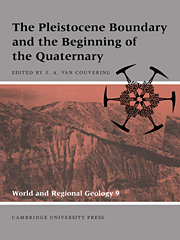Book contents
- Frontmatter
- Contents
- List of contributors
- Preface: the new Pleistocene
- Foreword
- Part I Definition of the base of the Quaternary
- Part II Characterization of the Pleistocene boundary-stratotype
- Part III The paleontological context of the Pleistocene boundary
- Part IV The Pleistocene boundary in regional sequences
- 11 The Pliocene–Pleistocene boundary in Italy
- 12 Stratigraphy of the Plio–Pleistocene sequence of the Mediterranean coastal belt of Israel and its implications for the evolution of the Nile Cone
- 13 The Pliocene–Pleistocene transition in the Iberian Peninsula
- 14 Biostratigraphy and calibrated climatic chronology of the Upper Pliocene and Lower Pleistocene of France
- 15 The Plio–Pleistocene of England and Iceland
- 16 The Neogene–Ouaternary boundary in The Netherlands
- 17 The Tertiary–Quaternary boundary in western Germany
- 18 The Pliocene–Pleistocene boundary in eastern Germany
- 19 The Plio–Pleistocene of Hungary
- 20 The Pliocene–Pleistocene boundary in Romania
- 21 The Pliocene and Pleistocene of the European part of the Commonwealth of Independent States
- 22 The N/Q boundary in Asian Russia and Tadjikistan
- 23 The Pliocene–Pleistocene boundary in the Indian subcontinent
- 24 The Pliocene–Pleistocene boundary in Japan: the Osaka Group, Kinki district
- 25 The Pliocene–Pleistocene boundary in Japan: stratigraphy in the Boso Peninsula, central Japan
- 26 The base of the Quaternary in China
- 27 Plio–Pleistocene deposits and the Quaternary boundary in sub-Saharan Africa
- 28 Plio–Pleistocene reference sections in Indonesia
- 29 The Pliocene–Pleistocene boundary in New Zealand
- 30 The Pliocene–Pleistocene boundary in continental sequences of North America
- Index
24 - The Pliocene–Pleistocene boundary in Japan: the Osaka Group, Kinki district
Published online by Cambridge University Press: 10 November 2009
- Frontmatter
- Contents
- List of contributors
- Preface: the new Pleistocene
- Foreword
- Part I Definition of the base of the Quaternary
- Part II Characterization of the Pleistocene boundary-stratotype
- Part III The paleontological context of the Pleistocene boundary
- Part IV The Pleistocene boundary in regional sequences
- 11 The Pliocene–Pleistocene boundary in Italy
- 12 Stratigraphy of the Plio–Pleistocene sequence of the Mediterranean coastal belt of Israel and its implications for the evolution of the Nile Cone
- 13 The Pliocene–Pleistocene transition in the Iberian Peninsula
- 14 Biostratigraphy and calibrated climatic chronology of the Upper Pliocene and Lower Pleistocene of France
- 15 The Plio–Pleistocene of England and Iceland
- 16 The Neogene–Ouaternary boundary in The Netherlands
- 17 The Tertiary–Quaternary boundary in western Germany
- 18 The Pliocene–Pleistocene boundary in eastern Germany
- 19 The Plio–Pleistocene of Hungary
- 20 The Pliocene–Pleistocene boundary in Romania
- 21 The Pliocene and Pleistocene of the European part of the Commonwealth of Independent States
- 22 The N/Q boundary in Asian Russia and Tadjikistan
- 23 The Pliocene–Pleistocene boundary in the Indian subcontinent
- 24 The Pliocene–Pleistocene boundary in Japan: the Osaka Group, Kinki district
- 25 The Pliocene–Pleistocene boundary in Japan: stratigraphy in the Boso Peninsula, central Japan
- 26 The base of the Quaternary in China
- 27 Plio–Pleistocene deposits and the Quaternary boundary in sub-Saharan Africa
- 28 Plio–Pleistocene reference sections in Indonesia
- 29 The Pliocene–Pleistocene boundary in New Zealand
- 30 The Pliocene–Pleistocene boundary in continental sequences of North America
- Index
Summary
Introduction
The INQUA Subcommission 1-d on the Pliocene–Pleistocene boundary organized the working group on the Neogene–Quaternary boundary as the action body for Project 41 of the International Geological Correlation Program (IGCP) in 1974. As a research and contact body corresponding to the INQUA subcommission, the Japanese National Committee for Quaternary Research in the Science Council of Japan organized the Japanese National Subcommission on the Pliocene–Pleistocene Boundary, chaired by M. Itihara. The Japanese national subcommission has functioned simultaneously as the Japanese national working group for IGCP-41 for investigations of the boundary problem in Japan.
In August 1982, the Japanese national working group for IGCP-41 presented its third report at the XI INQUA Congress in Moscow (Itihara and Kuwano, 1982). That report, however, covered too many areas (Figure 24.1) to be included in this final volume. Therefore, for this purpose, it was decided to select two representative studies: this chapter, on the Pliocene–Pleistocene boundary in the Osaka Group, as a typical section of lacustrine and fluvial sediments with marine intercalations, and Chapter 25, on the Plio–Pleistocene stratigraphy in the Boso Peninsula, as a typical section of marine sediments.
Background and stratigraphic framework
Deposits of Pliocene and Pleistocene age are well exposed in Japan (Figure 24.1). In the Osaka Group in the Kinki district of central southern Honshu, strata that correlate well to the interval containing the Pliocene–Pleistocene boundary have been studied or discussed by Itihara (1961), Ishida et al. (1969), Itihara and Kamei (1970, 1982), Itihara et al. (1973, 1975, 1984), and Maenaka et al. (1977). This chapter describes the present status of the problem of the Pliocene–Pleistocene boundary in this well-described sequence.
- Type
- Chapter
- Information
- The Pleistocene Boundary and the Beginning of the Quaternary , pp. 239 - 243Publisher: Cambridge University PressPrint publication year: 1996
- 6
- Cited by

